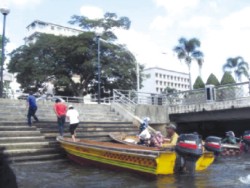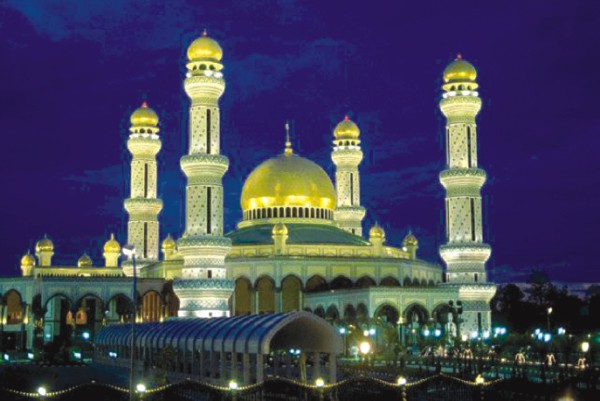|
Travel
Old World Charm
REVATHI MURUGAPPAN
 When tourists hear of Brunei Darussalam, they think of a country that is rich in oil and whose Sultan was once the richest man in the world before Bill Gates, Carlos Slim and others overtook him on top of the billionaire's list. When tourists hear of Brunei Darussalam, they think of a country that is rich in oil and whose Sultan was once the richest man in the world before Bill Gates, Carlos Slim and others overtook him on top of the billionaire's list.
But of course, there's more to Brunei than that. The roots of the country can be traced to a little village by the Brunei River, where villagers fished for a living and skilled craftsmen fashioned handicraft from brass, silver and wood to be traded around the region.
All this began in an area in the capital of Bandar Seri Begawan called Kampong Ayer or Water Village where houses are built on stilts as they were a thousand years ago. It is the biggest water village in the world, comprising a cluster of little villages and stretching over 8km along the river.
Kampong Ayer houses around 30,000 inhabitants (that's 10 per cent of the population), with each of the small villages of which it is comprised having its own chief, chosen by the people. Today, besides being a major tourist attraction, Kampong Ayer is designated as a national heritage site.
Italian scholar Antonio Pigafetta dubbed it the 'Venice of the East' when he travelled with Portugeuse explorer Ferdinand Magellan and his crew on their voyage to the Indies in 1512. Hence, the village is an important part of Brunei as it preserves the nation's river dwelling origins.
A walk in Kampong Ayer may just bring back memories of yesteryear. Intricate walkways and bridges connect the villages. Children sit on the pavement and play traditional games like congkak. A rooster may let out the occasional crow and another may respond. Artisans sit outside their homes carving wood, trying to keep alive the cottage industries of their ancestors. Old aunties and uncles sell snacks on the footpaths while others enjoy a cup of coffee.
Life is laidback and stress-free. From a distance, the village may look like a squatter town but it is self-contained and equipped with all the amenities of modern living, including schools, shops, clinics, mosques, a police station and fire brigade. A postman comes daily to deliver letters while garbage collectors pick up trash from specific sites every day.
However, some residents still throw their rubbish out into the water so parts of the village stick out like a sore thumb.

The government also provides piped water, telephone lines and electricity. Residents depend on boats or river taxis to ferry them across to the mainland. But don't assume they're poor just because their houses are on stilts and they run around barefoot. Most villagers have good jobs, own cars and even speedboats, which are parked underneath their houses.
“Yes, we have cars but since our homes are on water, we park our vehicles on the river bank. When people go to work or there's a need to go to town for grocery shopping, we take the boat, then drive our car out. Everyone has an allocated parking space,” says Masnah Masri, 41, from Kampong Setia 1.
The village is a unique architectural heritage of wooden homes with ornate interiors. The houses here are long and spacious with colourful walls and many doors. Flooring in Masnah's house is a mix of squares and vertical designs but, surprisingly, it's almost like patchwork because every area has its own blend of patterns.
Noting my puzzled expression, Masnah tells me, “It's just fashionable! There's no history behind the design. We just cut and paste the flooring to make it look nice.”
A photograph of Brunei's ruler Sultan Hassanal Bolkiah and his consort is prominently hung on one wall. On the opposite wall are the Brunei Crown Prince Al-Muhtadee Billah and his consort, Pengiran Anak Sarah Pengiran Salleh. Masnah proudly shows us the many photographs of tourists who have visited her family home as her son quickly clicks our picture.
Just then, her sister Ambun Masri walks in with her brood of grandchildren and greets us. At 55, she has more than a dozen grandchildren from 13 children. And three of her youngest kids are still unmarried.
Ambun complains that social problems among youths are increasing. She says, “Alcohol drinking is on the rise and these days, the police do their rounds three times a day. We try to punish the youngsters but sometimes, it doesn't work.”
In an effort to provide villagers with a better life, the government began offering villagers concrete houses on the mainland (priced around B$46,000 or US$33,500) in the early '90s. Some who could afford it, took up the offer but most, even the younger generation, want to stay put.
Masnah says she wouldn't turn her back on the village even if she did acquire a new concrete house.
“I applied for one in 1993 but still haven't received any news. My daughter wants me to move but I don't think I'll stay on the mainland permanently. My life is here with my friends and extended family, so I'll probably go there during the weekdays and come back here during weekends,” says Masnah.
The water village has a long history, and the government is highlighting this fact with the newly opened Kampong Ayer Cultural and Tourism Gallery.
Accessible by boat, the gallery allows a glimpse into the village's past with exhibits, photographs, records and archaeological findings dating from as early as the 10th century AD. If you happen to be in Brunei and have nothing to do, be sure to check it out.
This article was first published in The Star, Malaysia. Reprinted with permission; Asian News Network; all rights reserved.
Copyright
(R) thedailystar.net 2010 |
